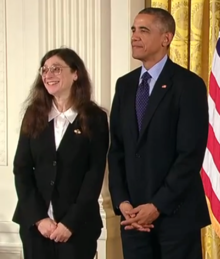American entomologist
May Roberta Berenbaum (born July 22, 1953) is an American entomologist whose research focuses on the chemical interactions between herbivorous insects and their host plants, and the implications of these interactions on the organization of natural communities and the evolution of species. She is particularly interested in nectar, plant phytochemicals, honey and bees, and her research has important implications for beekeeping.[1]
She is a member of the National Academy of Sciences and was named editor-in-chief of its journal, Proceedings of the National Academy of Sciences in 2019;[2] she is also a member of the American Philosophical Society (1996), and a fellow of the American Academy of Arts and Sciences (1996). She has held a Maybelle Leland Swanlund Endowed Chair in entomology since 2012, which is the highest title a professor can hold at the University of Illinois.[3] In 2014, she was awarded the National Medal of Science.
Early life and education
Berenbaum graduated summa cum laude, with a B.S. degree and honors in biology, from Yale University in 1975. Berenbaum discovered an interest in entomology after taking a course on terrestrial arthropods only because it fit her schedule, and found a second passion by taking an elective course in plant biochemistry.[4] After attending a research seminar on chemical ecology by Paul Feeny, she decided to integrate her interests in entomology and botany, and began a PhD supervised by Feeny at Cornell University.[4] Berenbaum received her Ph.D. in ecology and evolutionary biology in 1980.[5]
Research
Berenbaum is known for her research into the chemistry of honey and its importance as a functional food for bees and wasps in the superfamily Apoidea. As of 2021, approximately 20,000 bee species are known, but there are also signs of declines in bee populations in many countries. Berenbaum's research has shown that honey contains phytochemicals that help bees to tolerate cold, resist pesticides, fight off infections, heal wounds, and live longer. Important phytochemicals include p-coumaric acid, quercetin, abscisic acid, anabasine, caffeine, gallic acid, kaempferol, and thymol. Furthermore, sick honeybees will choose among different types of honey and eat the one that contains the phytochemicals that can improve their health.[1][6]
Berenbaum's work has important implications, suggesting changes to practices in the beekeeping industry which may help bees to survive. One conclusion is that floral diversity matters: bees that have the opportunity to make honey from a diverse range of flowers will be healthier bees. As well, beekeepers should leave their bees a variety of different honeys, gathered at different times from different plants, so that they have a "honey pharmacy" to choose from when ill.[1][6]
Career
Since 1980, Berenbaum has been a member of the faculty of the department of entomology at the University of Illinois Urbana-Champaign and has served as head of the department since 1992.[7]
In 1996, she was elected a Fellow of the American Academy of Arts and Sciences[8] and she was elected a member of the American Philosophical Society in the same year.[9]
She served as the editor of Annual Review of Entomology from 1997 until 2018,[10] and was named editor-in-chief of Proceedings of the National Academy of Sciences USA in 2019.[2]
She has also chaired two National Research Council committees, the Committee on the Future of Pesticides in U.S. Agriculture (2000) and the Committee on the Status of Pollinators in North America (2007).[11]
She has written numerous magazine articles, as well as books about insects for the general public:
- Ninety-nine gnats, nits, and nibblers (1989)
- Ninety-nine more maggots, mites, and munchers (1993)
- Bugs in the system: insects and their impact on human affairs (1995)
- Buzzwords: a scientist muses on sex, bugs, and rock'n roll (2000)
- Earwig's tail: a modern bestiary of multi-legged legends (2009)
- Honey, I'm homemade: sweet treats from the beehive across the centuries and around the world (2010)
Berenbaum has also gained some measure of fame as the organizer of the Insect Fear Film Festival at the University of Illinois Urbana-Champaign.[5]
Personal life
Berenbaum is a strict vegetarian in her personal life. She has researched and taught entomophagy to her students, but never eats insects herself.[12][13]

